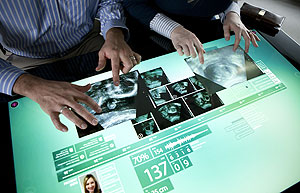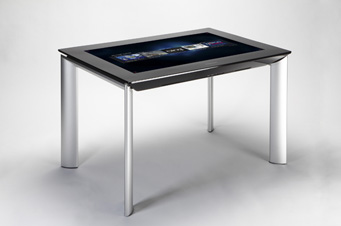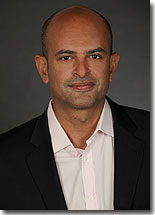REDMOND, Wash. – Nov. 17, 2011 – Retail outlets looking for new, innovative ways to get hands-on with their customers will soon have a new tool – the Samsung SUR40.
Companies are already using Microsoft Surface to give potential customers virtual tours of plane interiors, help them plan flights, provide them with the ability to create immersive photo books, and entice bank customers into brick and mortar branches. Those experiences only hint at how the new Surface device will be able to help businesses engage with customers, said Somanna Palacanda, director of Microsoft Surface.

Retailers, healthcare providers and others looking for new ways to get hands-on with their customers will soon have a new tool – the Samsung SUR40.
“With what’s happening in the world of touch and the fact that touch is becoming ubiquitous, people are looking for more immersive relationships with screens,” he said. “The new Surface takes technology that’s always existed in the backs of stores and brings it front and center. So now customers and retailers can interact together, a doctor and a patient can have a more immersive consulting experience, and a banker and a customer can sit together and work on a simulation where in past the banker would be the only one in control.”
Samsung and Microsoft announced today that a new, more versatile Microsoft Surface device is now available for pre-order, the near final stop on its journey from lab to marketplace. Now, businesses in 23 countries can visit the Samsung website to find a local reseller and place an order for the Samsung SUR40. Shipments are expected to start early next year.

The second, more retail-friendly version of Microsoft Surface is lighter and thinner than the original.
The Samsung SUR40 was just named a 2011 “Best of What’s New” award winner by Popular Science magazine and is featured in a special awards issue currently on newsstands. Corinne Iozzio, senior associate editor at Popular Science, said the magazine’s editors were impressed with the update to the original Surface, a 2008 “Best of What’s New” winner.
“We very much liked the idea of the package of the Surface, which had packed so much computing intelligence and so much sensor technology into such a thin package,” she said. “It’s a tabletop that can be put anywhere without harming the functionality and in fact makes a system like the Surface much more accessible.”
The Samsung SUR40 also earned strong praise by the likes of Forbes and Gizmodo when released at the Consumer Electronics Show earlier this year.

Somanna Palacanda, director of Microsoft Surface.
Palacanda said the new Surface device incorporates all the key features of the original – a massive multi-touch screen, the ability to recognize fingers, blobs, and objects – as well as PixelSense, a new technology that lets LCD panels “see” without the use of actual cameras. The technology has helped slim down the second version of the Surface device and enables a new form factor – one that can be turned on its side. With a screen that’s only four inches thin, customers will have the option to use the Samsung SUR40 horizontally as a table, hang it on a wall, or embed it into furniture, Palacanda said.
“We listened to our partners and customers’ requests for a lighter and thinner form factor that gives them flexibility because there’s no one-size-fits-all in the retail space,” he said.
Several existing Surface customers, including Dassault Aviation, Fujifilm Corp. and the Royal Bank of Canada (RBC), plan to use the Samsung SUR40 in locations around the globe early next year. RBC is already using the first version of Surface as a new medium to engage with its customers, Palacanda said.
He explained that RBC is redesigning their stores to offer customers a new retail experience, where Surface is playing an important part. For example, RBC launched a direct mail campaign to invite their customers into their stores through a sweepstakes. When customers visit, they drop their brochure onto the Surface machine to find out if they’ve won a prize. At the same time, RBC employees can use Surface to highlight the bank’s products and services.
The results encouraged RBC, Palacanda said. A typical direct mail response rate is less than 1 percent; RBC is seeing a conversion of above 10 percent.
“We’ve always spoken about collaboration from a computing standpoint, but before Microsoft Surface we truly did not have a device where two or more people could actually engage together with the same piece of digital content,” Palacanda said. “I think this announcement is the first step in delivering a next generation device that improves even further on the original Surface experience, which enables two or more people to collaborate in a very meaningful way.”
The new device is also popular with developers, said Luis Cabrera-Cordón, senior program manager for Microsoft Surface. The Surface 2.0 software developer kit (SDK) was released at MIX11 in April, and already it’s been downloaded more than 7,000 times.
The SDK features an input simulator that enables developers to write Surface applications on any Windows 7 PC, an approach Cabrera-Cordón called “Write once, touch anywhere.”
“The SDK allows developers to write a single application that can adapt to all sorts of types of hardware,” he said. “That makes for a great investment: they can target Microsoft Surface hardware as well as any Windows 7 touch-enabled PC. This is a flexible platform so developers can create the best user interface for the person actually using the computer.”
Cabrera-Cordón encouraged developers to download the SDK and start building apps as the Samsung SUR40’s release date draws near.
“Touch apps are an area that is new. There is a lot to discover and innovate on,” Cabrera-Cordón said. “And I hope that by playing with the Surface 2.0 SDK, they’ll discover they can innovate and create things that we don’t have today.”




